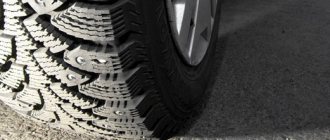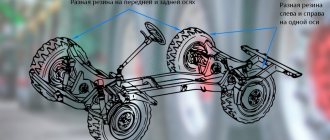Tread - wear rate
Car tires inevitably wear out over time. The wear rate of a car tread is influenced by many factors:
- operating conditions and technical condition of the vehicle;
- road surface condition, weather conditions;
- driving style;
- vehicle mileage;
- tire manufacturer;
- price range of products.
Measuring the thickness of the tread layer will allow you to accurately determine the degree of tire wear and make a timely decision to replace unsuitable tires with new ones.
Methods for measuring the tread height of winter tires
Modern manufacturers make it much easier to monitor tire tread wear. For this purpose, a special indicator is provided on the tire, which can be presented in the form of a colored layer, a pictogram or an indication of the number of mm. As this designation wears off, the driver can understand whether the tires need to be replaced with new ones.
If the tires do not have a wear indicator, you can use improvised means (a coin) or special devices:
- electronic depth gauge;
- ruler;
- caliper with depth gauge.
These devices are simply lowered between the blocks and show the current winter tire tread height. If you don't have them on hand, you can use a coin. It sinks edge deep. The place where the protector ends is clamped with your finger. All that remains is to measure the resulting height with a ruler. This method is not very accurate and is used as a last resort.
In order for tread depth monitoring to be accurate and informative, measurements must be taken across the entire width and at different points of the radius. The final value is taken to be the minimum height identified during the test. If you notice uneven wear on the tread pattern, it is worth checking the wheel angle for camber and toe.
Traffic rules: for safety reasons
Different tires have different wear limits. Tread depth affects vehicle handling and road safety. According to Chapter 5 of the Traffic Regulations, maximum standards for the height of the tread pattern are established. For category M1 - passenger cars, as well as vehicles of categories N1, O1 and O2, the minimum permissible value is 1.6 mm. When operating winter tires on snowy or icy surfaces, the limit is 4 mm. A traffic police officer has the right to measure the residual depth with a verified device. If a violation is detected, a fine is imposed on the car owner.
Changes to the list of faults
Let's start with the changes made to the list of faults for which the operation of vehicles is prohibited:
5.1. Passenger car tires have a residual tread depth of less than 1.6 mm, truck tires - 1 mm, buses - 2 mm, motorcycles and mopeds - 0.8 mm.
Note. For trailers, standards for the residual height of the tire tread pattern are established, similar to the standards for tires of vehicles - tractors.
5.1. The remaining tire tread depth (in the absence of wear indicators) is no more than:
for vehicles of categories L - 0.8 mm; for vehicles of categories N2, N3, O3, O4 - 1 mm; for vehicles of categories M1, N1, O1, O2 - 1.6 mm; for vehicles of categories M2, M3 - 2 mm.
Residual tread depth of winter tires intended for use on icy or snowy road surfaces, marked with a sign in the form of a mountain peak with three peaks and a snowflake inside it, as well as marked with the signs “M+S”, “M&S”, “M S” ( in the absence of wear indicators), during operation on the specified coating is no more than 4 mm.
Note. The designation of the vehicle category in this paragraph is established in accordance with Appendix No. 1 to the technical regulations of the Customs Union “On the safety of wheeled vehicles”, adopted by decision of the Customs Union Commission dated December 9, 2011 No. 877.
First of all, the categories of vehicles from the technical regulations that were not previously mentioned in the traffic rules are striking.
Let's compare the remaining tread depth before and after January 1, 2015:
| Remaining tread depth | Until January 1, 2015 | After January 1, 2015 |
| 0.8 mm | motorcycles and mopeds | L - mopeds, motorcycles, quadricycles, etc. |
| 1 mm | trucks | N2, N3, O3, O4 - trucks with a permissible maximum weight of more than 3.5 tons and trailers with a permissible maximum weight of more than 3.5 tons |
| 1.6 mm | cars | M1, N1, O1, O2 - cars, trucks with a permissible maximum weight of up to 3.5 tons, trailers with a permissible maximum weight of up to 3.5 tons |
| 2 mm | buses | M2, M3 - buses |
The changes affected trucks with a permissible maximum weight of up to 3.5 tons, i.e. trucks of category B. Previously, on such vehicles, rubber could be used until 1 mm of tread remained. From January 1, 2015, the requirements will be slightly more stringent - 1.6 mm. For example, these requirements will affect small trucks (Gazelle, Mitsubishi L200, Volkswagen Amarok, etc.).
In addition, additional requirements are being introduced for winter tires marked “M+S”, “M&S”, “M S”. Such tires must have a residual tread depth of at least 4 mm. Moreover, this value does not depend on what category of vehicle the tires are installed on.
Summer tires
The new summer tire has an average tread depth of 7-8 mm. The service life of summer tires is, as a rule, 3-5 seasons with average mileage and moderate driving style. The legal limit on residual height is 1.6 mm. However, with 3 mm of the outer layer remaining, the car is already difficult to control, grip deteriorates, and a safety hazard arises. You should not wait to reach a critical value. Make sure to change your tires in advance.
Why is it important to monitor tread depth?
While the vehicle is moving, the tire must a priori have good grip on the road. It is the quality of the element in question that directly affects driving safety in different weather conditions. In practice, it turns out that tire tread depth is a critically important indicator for cars of any type and brand.
To achieve optimal values, tire manufacturers specially develop suitable rubber options with different patterns that are suitable for a variety of operating conditions:
- asymmetrical – ensure the vehicle’s maneuverability during cornering maneuvers, such tires are ideal for driving at high speeds and are almost silent;
- directional - suitable for drivers who prefer a moderate driving style, as they have a special level of efficiency in removing liquids from the contact patch;
- symmetrical - are considered a more universal analogue for traveling on city roads and highways, because they cope with aquaplaning without problems and guarantee confident control.
But no matter what style the car enthusiast chooses, and no matter what tread pattern he chooses, it is first of all important to monitor the depth. When tires wear out, they quickly lose traction with the road surface, the car becomes less stable, and the movement ceases to be smooth and comfortable; you begin to feel unpleasant jolts.
At the same time, the braking distance of tires on wet asphalt increases and the quality of forced stopping decreases even during hot weather: all this occurs due to a decrease in the weight of the wheel due to wear.
Winter tires
Winter tires are used in harsh weather conditions: low temperatures, icy conditions, snowy road surfaces. Worn elements make the tire ineffective on slippery winter roads. Accordingly, a more serious approach to the condition of tire tread is needed. Studless friction rubber (Velcro) initially has a tread height of 8-9 mm. The new studded tire is from 9 to 11 mm; some companies produce a tread height of 12-18 mm. When the tread wears down to 4-5 mm, winter tires require replacement. In addition, the loss of more than 50% of metal studs is also a reason to change your car's shoes. The average service life of winter tires is 2-4 years.
All-season tires
The universal all-season vehicle is used in temperate climates both in winter and summer, optimal at temperatures from +10 to -10˚C. Such tires are not suitable for use in snowfall or severe frosts. Traffic regulations allow the use of all-season tires in winter if they have special markings:
- a sign in the form of a mountain peak with a snowflake inside;
- M+S;
- M&S.
All-season tires last on average 3-4 years. In summer, when temperatures are high, all-weather tires wear out much faster. It is recommended to buy new tires when the tread layer has worn down to 2-2.5 mm.
Methods for measuring tread depth
You can estimate the remaining tread layer in various ways:
- Special volumetric indicators in the form of jumpers: if the tread layer wears down to the level of the jumpers, the tire is not suitable for further use.
- Manufacturers stamp numbers of varying depths on the surface of some types of tires. Wear is assessed visually, by the visibility of individual numbers.
- Using measuring instruments: from a metal ruler, caliper or depth gauge to an electronic tread depth gauge.
How to measure remaining tread depth
If there are no manufacturer's marks, you can measure the tread balance for winter tires yourself. For this purpose, specialized tools or improvised means are used. The measurement parameters will influence the decision on the use of tires.
Main tread depth measuring motors:
- a special device with a retractable rod and a measuring scale;
- calipers;
- ruler;
- any object that can be placed in the groove.
Measuring manipulations are carried out in several places on each bus. The difference in readings is acceptable if its value does not exceed one millimeter.
Buying tires: new or used
Old tires have become unusable, the amount of tread remaining is approaching a critical point - there is no need to take risks, it’s time for your car to change its shoes. Do you want to spend little money and buy used tires? Be careful! Sellers indicate in their advertisements the condition of used tires as good or excellent. Don’t be too lazy to measure the height of the tread layer yourself. And remember: for winter tires, a value of 4 mm is already 100% wear. The quality of domestic roads, unfortunately, does not allow tires to be used for 7-10 years. Purchasing used car tires is always a risk of buying products with extreme wear.
Don't skimp on safety. Buying new tires will require a larger investment, but will pay off with a long period of trouble-free operation.











